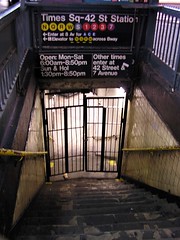 When the Senate finally approved the MTA funding, our state’s less-than-august legislature did so with nary an air of finality. They do so more with the last sigh of someone fed up with the topic.
When the Senate finally approved the MTA funding, our state’s less-than-august legislature did so with nary an air of finality. They do so more with the last sigh of someone fed up with the topic.
For months — since February — the state legislature has dealt with transit issues on a near-daily basis. They have known for over a year that the MTA’s financial Doomsday would arrive in 2009, and they did nothing. While Gov. David Paterson solicited a Richard Ravitch-inspired plan that would have cut congestion while funding a transit renaissance in New York, our backwards legislature couldn’t stomach the costs of that plan.
In the end, the Senate acted six weeks after the MTA’s self-imposed deadline passed. They acted at the 11th Hour and at the behest of a very unpopular governor. The resulting compromise — discussed in detail here — are far from satisfactory, and while the ink has hardly dried on the approved bill, it is receiving a less-than-enthusiastic reception. William Neuman and Nicholas Confessiore have more:
The State Legislature passed a series of new taxes and fees late Wednesday night meant to keep New York’s base subway fare from rising above $2.25 this year. But the hastily drafted bill, approved largely along party lines, raised many questions about how the plan would work and how effective it would be in stabilizing the struggling Metropolitan Transportation Authority.
In the short term, the plan would appear to raise significantly less money this year than in some earlier projections, although legislative staff members said it would be enough to get the authority through the year. There were also questions about how a 50-cent surcharge on yellow cab rides in New York City would be collected from thousands of taxi drivers and owners…
Questions also remained about the authority’s capital spending program, which is only partially financed in the rescue plan.
The bill’s problems though are immediately evident. First are the economics behind it. The MTA is facing a deficit this year of $1.8 billion. Since the taxation and fee structure won’t be enacted until part of the way through 2009 though, the money may not be there to cover the whole deficit.
According to reporters from Albany, the MTA will receive just $1.1 billion this year. Where the other $700 million will come from is up in the air. A recent move by the MTA Board to lengthen the agency’s fiscal year to 18 months may provide them with an opportunity in 2010 to balance the books this year. The answers though are hazy.
Of additional concern are problems of collection. As the Daily News editorial board explained yesterday, no one knows how to collect this taxi surcharge. The Taxi and Limousine Commission has never enacted a city-wide fee of this nature, and considering the relatively loose and independent reporting procedures for cab fares, there is no simple system in place here.
Beyond the short-term impact though are the long-term problems. As John Petro from the Drum Major Institute detailed in a short post entitled “MTA Rescue Spineless” and on SAS yesterday, Albany is again forcing the MTA to borrow to maintain a state of good repair and fund necessary upgrades and expansion plans.
“Without long-term investments in capital needs, the MTA will forever be facing budget shortfalls, deferred maintenance, crumbling stations, and stalled projects,” he writes. “We will be back at square one soon enough. This vicious cycle needs to end.”
Petro is spot-on. The approach to transit in New York City is completely broken. We may have averted Doomsday today, but these issues will not go away until the state’s approach to transportation undergoes a massive reform. As long-time SAS reader Boris said earlier this week, “Even among New Yorkers there are many people who don’t think the subway can, or should, be better than it is. It’s all they know.” That attitude is a recipe for sub-par transit in a city aiming to keep up with smarter and better-equipped global competitors.

 Gov. David Paterson knows he doesn’t have a ground-breaking plan to fund the MTA on tap. In fact, he is willing to admit that his plan is simply a stop-gap measure designed to halt a fare hike and avoid crushing service cuts, and he
Gov. David Paterson knows he doesn’t have a ground-breaking plan to fund the MTA on tap. In fact, he is willing to admit that his plan is simply a stop-gap measure designed to halt a fare hike and avoid crushing service cuts, and he 